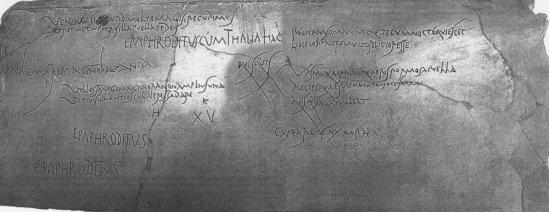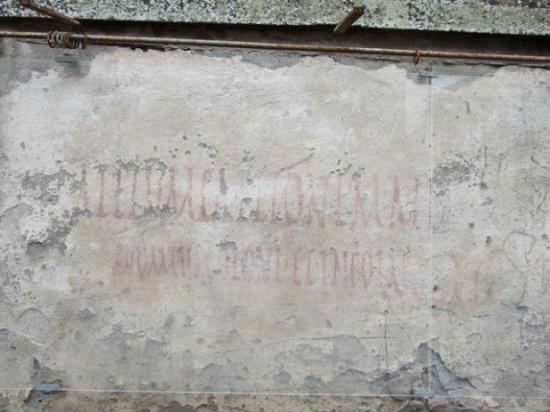Susanna Pilny
Source - http://www.redorbit.com/news/science/1113411831/why-ancient-roman-graffiti-is-so-important-to-archaeologists-010516/#MRkzlFvEQsQycxAj.99
Pompeii’s graffiti is the world’s most frustrating goldmine.
When it comes to ancient Rome, the vast majority of insights into their world we have are from one group: Wealthy (or patronized) free men. According to Charles Freeman[1], in all of the surviving works from Rome, only one author speaks of his life as a former slave—a philosopher named Epicetus. Meanwhile, every female Roman voice has been lost to time.
But there is one place on Earth that may yet hold their stories: The Bay of Naples, where in 79 CE, Mount Vesuvius buried the two seaside towns of Pompeii and Herculaneum under feet of lava and ash. These places weren’t necessarily vast repositories of lost literature, but the eruption froze them nearly perfectly in time, preserving them for nearly 2,000 years—and preserving thousands of pieces of graffiti along with them.
Now, in modern times, graffiti bears the notions of vandalism and illegality, usually resulting in small, hasty scribbles of “Joanie loves Chachi” or some anatomically-puzzling genitalia (which was actually pretty true for Pompeii, too). But, unlike today, Roman graffiti was not forbidden—and it was practically everywhere, from the private dining rooms of wealthy homes (domi, where friends sometimes left messages for the hosts) to the public forum. In fact, according to Kristina Milnor[2], more 11,000 graffiti images have been found in Pompeii—which is just about the size of the population at the height of the town.
 Poetry graffito from the stairwell of the House of Maius Castricius, Pompeii. (Credit: Wikimedia Commons)
Poetry graffito from the stairwell of the House of Maius Castricius, Pompeii. (Credit: Wikimedia Commons)
The evidence of lack of restriction is probably best demonstrated by the fact that there doesn’t seem to have been a Latin word for graffiti—the words typically associated with it were those of writing or drawing*, like pictor (painter). Reading between the lines, it seems ancient graffiti was much less seen as destruction of public property and more as a public and acceptable form of self-expression and advertisement.
The text of the everyman
Without this threat of punishment, it seems that graffiti was readily practiced by people at all strata of society, making it perhaps the most valuable text we have from the ancient world. Man, woman, child, slave, poor, rich, illiterate—it did not matter, so long as there was an empty spot on a wall. Which means that, through graffiti, we are able to hear the voices of those who have been traditionally voiceless, granting us the possibility of astounding insights into lives and minds we’ve never been able to access.
And the variety of what has been found is astonishing. There is graffiti from foreigners passing through Pompeii, often scratched near the gates (“Feliciter Pompeii” was a common way to wish the city well). Or little drawings of gladiators, animals, and the like:
 Graffito of gladiators, from the House of Fabia and Tyrannus, Pompeii. The inscription reads, “Oceanus, of free status, victorious 13 times, won. Aracintus, of free status, victorious 4 times, earned a reprieve.” (Credit: ©Jackie and Bob Dunn, www.pompeiiinpictures.com. Su concessione del Ministero dei Beni e delle Attività Culturali e del Turismo - Soprintendenza Speciale per i Beni Archeologici di Pompei, Ercolano e Stabia.)
Graffito of gladiators, from the House of Fabia and Tyrannus, Pompeii. The inscription reads, “Oceanus, of free status, victorious 13 times, won. Aracintus, of free status, victorious 4 times, earned a reprieve.” (Credit: ©Jackie and Bob Dunn, www.pompeiiinpictures.com. Su concessione del Ministero dei Beni e delle Attività Culturali e del Turismo - Soprintendenza Speciale per i Beni Archeologici di Pompei, Ercolano e Stabia.)
There was crude (by modern standards) sexual humor, such as, “Floronius, privileged soldier of the 7th legion, was here. The women did not know of his presence. Only six women came to know, too few for such a stallion.” And there was plenty more: advertisements for apartments for rent, prostitutes, and political campaigns; poems seemingly composed on the fly; records of debt; love letters; mockery; puns; poems found scratched on doorways by rejected lovers standing outside; quotes from great works of Roman literature; alphabets; words and phrases in other languages, like Greek or Safaitic (a sort of pre-Arabic).
Seeds of change
Naturally, all of these works have slowly changed ideas on what Roman life was like at the time.
One interesting example has to do with the extremely disliked Nero—the infamous Christian persecutor who was suspected of burning Rome down and who had his own mother murdered. Amazingly, according to the graffiti around Pompeii, Nero actually wasn’t as disliked by Romans as historians have believed. In fact, it’s estimated that more than half of the graffiti found praising emperors lauds Nero.
His popularity apparently only took a sharp, permanent downturn when he kicked his pregnant wife, Poppaea, to death. Yet, when his memory was condemned by the Senate following his death, and his statues were effaced, it appears that the people of Pompeii did not destroy the graffiti praising him—perhaps indicating that, despite everything, he still was in favor.
Functionally literate
Another long-held belief was that very few members of Roman society were literate, especially in the case of the lower classes. However, the graffiti found in the ruins of Pompeii and Herculaneum seem to tell otherwise.
For example, a common aspect of campaigning for political office involved painting an advertisement (programmata) on the wall of a building in a busy area. This required one to hire (literate) men to grab a ladder, some torches, and a whitewasher to paint a well-worded vote of confidence in the middle of the night. Which begs the question: Why would one bother to hire men to paint an advertisement if so few people could read it?
 From the exterior of the House of the Sarno Lararium, Pompeii: “We the town’s citizens and resident aliens ask for Gaius Ateius Capito as aedile [a low-level public official].” (Credit: ©Jackie and Bob Dunn, www.pompeiiinpictures.com. Su concessione del Ministero dei Beni e delle Attività Culturali e del Turismo - Soprintendenza Speciale per i Beni Archeologici di Pompei, Ercolano e Stabia.)
From the exterior of the House of the Sarno Lararium, Pompeii: “We the town’s citizens and resident aliens ask for Gaius Ateius Capito as aedile [a low-level public official].” (Credit: ©Jackie and Bob Dunn, www.pompeiiinpictures.com. Su concessione del Ministero dei Beni e delle Attività Culturali e del Turismo - Soprintendenza Speciale per i Beni Archeologici di Pompei, Ercolano e Stabia.)
The same goes for other advertisements as well, like for goods, apartments for rent, or prostitutes, such as this one found on the Street of the Theatres: “A copper pot went missing from my shop. Anyone who returns it to me will be given 65 bronze coins [roughly 26 days of wages for a soldier]. 20 more will be given for information leading to the capture of the thief.”
A rich man is less likely to care about such a small amount of money, and would likely own his own domus (house) in lieu of living in the working-class apartment buildings known as insulae. So who was expected to read and care about such things?
Moreover, in graffiti scratched into the soft plaster walls of various buildings, there seems to be examples of what some call “recreational literacy”. As in: There are what appear to be many attempts of people practicing writing alphabets and practice sentences, likely in an attempt to boost their ability to read and write. Paper was expensive, but walls were free and easy to scratch—and thus were the perfect place to drill oneself.
There are also a large number of references to Roman literature, especially Virgil’s Aeneid, which suggests that such works were widely-known throughout society. This of course doesn’t necessarily indicate literacy, but the first few words of the Aeneid, “Arma virumque cano” (I sing of arms and the man”) are so prevalent, it seems that they were widely memorized at all levels of society. In fact, those words were so famous that it seems a clever pictor painted this for a political campaign:
 Progamma in grey, with pictor's "arma virumque" below. Author added representative drawings based on other images. (Credit: Wikimedia Commons)
Progamma in grey, with pictor's "arma virumque" below. Author added representative drawings based on other images. (Credit: Wikimedia Commons)
The programma here is written in the boldest black, and the same paint is used to write the first words of the Aeneid—meaning the pictor wrote both of them. Such a practice wasn’t unusual; sign writers often filled in space around a programma with unrelated words or phrases.
Here, however, the pictor got clever. A previous programma had the letters DIDOVF in it; the new programma used the first four letters, DIDO, to make a sort of wordplay by writing the Aeneid quote under it—as Queen Dido was the great tragic love of the Aeneid’s protagonist, Aeneas. Thus, this not only demonstrated the pictor’s skills and sign writing abilities, but also added a sort of “learned” joke that could have scored his candidate some bonus points.
In short, it seems that ancient Romans, as a whole, were much more literature (and steeped in works of literature) than previously guessed—which would only make sense. At the very least, functional literacy, or knowing how to read key things like prices, seems like it would have been much more common than absolute illiteracy.
PART.2